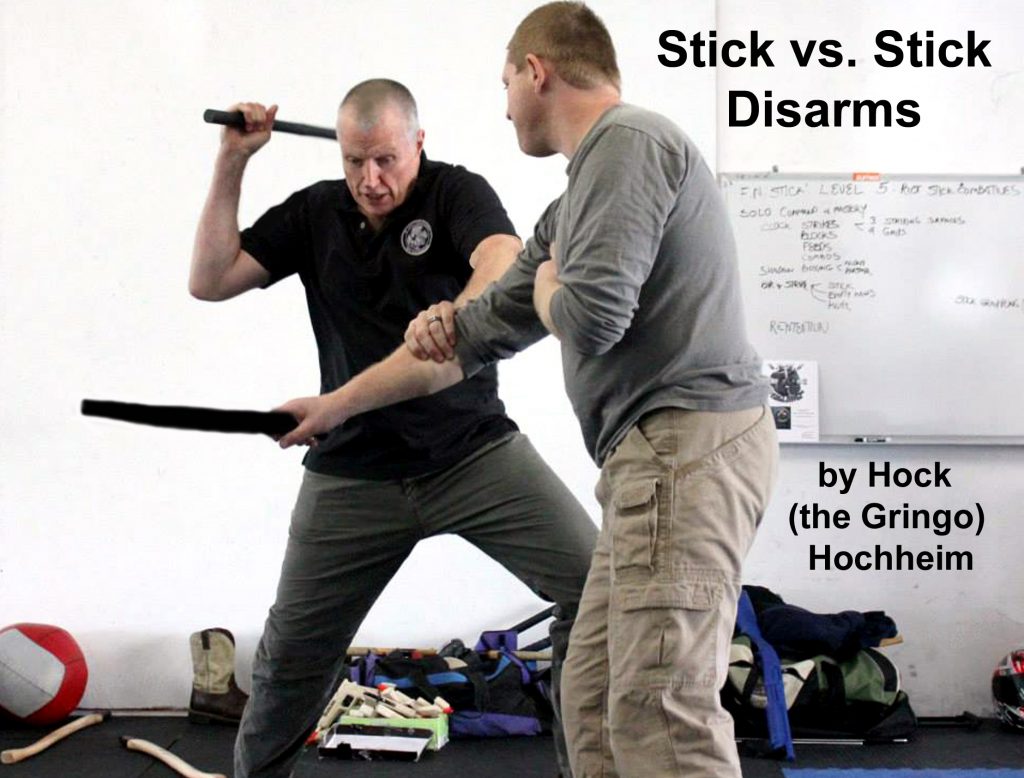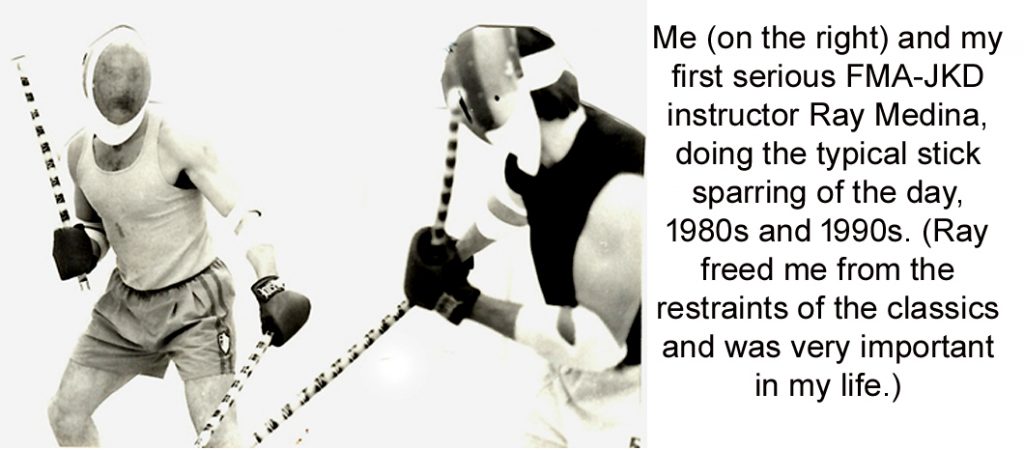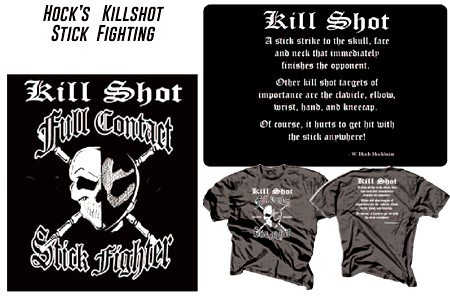In the big picture of fast and furious, speedy, adrenalized stick fight, where does the single stick disarm exist? How can it? Let’s take a look. An important way I think for starters, is to first examine the overall Filipino Martial Arts (FMA) subject of stick versus stick disarming. I identify really only FIVE stick vs. stick disarm categories…in the universe!
- 1-Impact Disarms (pretty self-explanatory).
- 2-Stick-side snakes (the stick and stick limb circles clockwise or counter-clockwise)
- 3-Support-side arm snakes, (empty hand limb snakes (circling clockwise or counter-clockwise)
- 4-Strip and keeps (because you caught and kept the stick, then push-pull it away from him)
- 5-Strip and sends (because you caught his weapon limb, and push-pulled the stick off-off-off)
- (Note: Collect disarms and stick them into categories for organization)
- (Note: Take note to see if instructors sneak a simulated, stunning blow in, as soon as possible within the disarm steps. Stunning really helps.)
- (Note: Some intermingling gets involved but usually the real core, successful move can be identified by the successful one. You’ll know it when you see it.)
Thus far for me, all the disarms in the universe, the galaxy (!) fit well into one of these 5 general categories above. Impacts and lots of circles and push-pulls, huh? Which is another way to help teach and summarize-explain the subject. List the raw movement concepts within the 5 disarm categories. Here are the three raw movements inside all the disarms categories.
- Disarm Raw Movement 1: Hits! Impacts (a hit to arm, the knee or head, torso, even a hard hit on a stick, can cause a drop),
- Disarm Raw Movement 2: Circles! (both arms clockwise and counter-clockwise circles)
- Disarm Raw Movement 3: Grabs, push-pulls and pulls-pushes. (Grabs on weapon, grabs on weapon-bearing limb)
I have had the opportunity to dissect and teach this list of 5 disarm categories (and their 3 movements within) around the world for years now and some, even semi-famous FMA instructors refused to believe this 5-list rendered, simplicity.
“How can it all be that simple? NO! It can’t be,” they sometimes say, “well then, what about this one?” they ask and show a disarm.
“Well that’s a strip and keep because you caught and keep this stick,” I would say.
“Well then, what about this one?” Demo…
“I would say, strip and send because shipped the stick away.”
And so on and so on, the challenges were fun to explore and always help me refine, refine, refine.
Five categories. Three raw ways to do them. Simple? Complicated? Traditional disarms are often taught and passed on in disorganized ways, usually created by artistic people with no scientific sense or teaching-organizational skills (like so many nutty katas, huh!). As a student in various FMA systems since the 1986, I have seen many of these disjointed disarm lists that miss the opportunity for smooth education, conformity and simple understanding.
For example, many disarms are glued to traditional angles of attack system. “Guro Jose” has 10 angles? And he demands – “Do this different disarm at each angle. And here they are. Memorize!” Many traditional disarms are passed along by doing…say…one mandatory disarm at their angle 5, (6, or whatever angle), when actually an angle 5 attack might be disarmed by 3 or 4 different ways. Best to pick a disarm category first and experiment doing it against all 10 angles. It will work sometimes and then not. One might call that process reverse engineering? This is a way to make your own list. Self-discovery experimentation is great, recognized, retention method.
Anyway, a search for easy, relatable explanations and mental retention must be conducted. But for many FMA systems and instructors, simplicity was-is not their mission, and after all, complexity is the fun – wow factor- cool goal. That fun, wow stuff, and-or then the regurgitation of their historic art is more important than say…the simple, sheer freedom to fix and improve things.
After the list of disarms with the 5 categories, understanding how they are executed with the 3 raw movements, it was time-saving and thorough for me to make the next list of counters to disarms. (For me, the counter study was really related to thwarting the 3 movements. What universal things could be done to counter them?)
- Any early-phase counters
- Any mid-phase counters
- Any late-phase counters
OKAY! Quick Disarm Tip: FMA stick is primarily a play within the Rectangle and-or “X’” box, and-or figure 8 circle, areas in front of your body betwixt the two opponents. Not as many training attacks come down from straight above, or up from low-low (there are a few more low than from straight down, still not enough). How did I determine this? Just examine your system and other system’s angles of attack drills to check this. One or maybe two angles of their 8, 10 or 12 angles comes straight down from above. The rest are side-to-side thrusts or slashes in that rectangle. In Guro Jose’s system, only one angle came down from above, the other 9 were other attacks. This means his system by innocent doctrine, de-emphasizes the common from 12 o’clock high, downward attack! One out of ten. On these high and low problems…

“Hock, connect sticks high? Then force the contact DOWN to the left or right sides where there are more and easier disarms. Low? Connect sticks low? Then force the contact UP to the right or left sides where there are more and easier disarms.” (Okay! Did Moses bring that tip down on another tablet we didn’t see? It was very helpful, conceptually.)
Okay, back to making your own list and using it in sparring. Free and eclectic. You got your list! Next, can they be done fast? Under pressure? The subject of this essay! We can all do them slow, sure. But so, in the big picture of fast stick fighting-sparring, how does the proverbial stick disarm exist? Can it exist? I know a lot of veteran hardcore stick fighters and they say they hardly ever saw a semi-elaborate move. It seems that in a full-blown stick fight-sparring (but with protection-see below), all semi-elaborate moves and elaborate moves are very hard to do and hard even to see-find in usual stick sparring.
In the same way we only see…ohhh, what? Eight, ten basic, non-elaborate, fundamentals in UFC fights, over and over again, and nothing elaborate seems to manifest, because the elaborate is usually hard to insert in the world of full speed and adrenaline. (I might add the impact disarm is probably the most common?)
I have found that in order to fully understand the possibilities of disarming in full action mode, I had to cut stick fighting-sparring into two categories and understand “stun, no-stun.”
Stun, No-Stun? Protective gear or not, you can do a few more things, go a little deeper in moves, be a little more “semi-elaborate” when an opponent is stunned-wounded. (Some come to you diminished, are naturally slow, untrained, etc. like their stunned!) If very stunned? Then elaborate! Sooo, protection matters!
- Sparring Category 1: Helmeted, protective gear for sport-fun-hobby. Less stun possibilities.
- Sparring Category 2: “Street survival,” for lack of a better term. No protection! I mean, do you really think you’ll be on Johnson street, with your 28” stick and get into a fight, coincidentally with another guy with a 28” stick? The “street” reality of such a dual, 28” stick duel is mostly nonsense for most of us. Odds are in most countries, no. But remember, no helmets, no pads, more stun.
So, single-stick sparring within the Stun, No-Stun universe:
- Stick sparring WITH helmets and gear protect against such stunning diminishments, making disarms and elaborate moves a bit harder to pull off. Less stun factor. Which might explain why you don’t see many. I wouldn’t let this depress you or dismay you much, because it’s not fully a real-deal…
- Stick fighting WITHOUT helmets and gear allow for more serious injury and then that might allow for a bit more elaborate material. Of course you are crazy to train this way, full out, all the time. You and-or your brain won’t make it to 30, 35 or 40 years old? You’ll dribble when eating.
Stick sparring with sturdy helmets and protective gear frequently ends in grounded wrestling matches because of the protection and limited, reality stun factor. Much FMA stick-duel instruction is given under this art-sport umbrella. Stick sparring without any such gear at all frequently ends in an ambulance.
Disarms! Who or what, where, when, how and why…are you? These questions define your training mission, your end goal. They create the important nuances of doctrine (and disarming). I surmise that that many practitioners think about all or any bit of these points and just play around in the art for the wow, the fun, the hobby. Wow! Which is absolutely fine, I only ask folks…just…know what they are doing who, what, where, when, how and why.
__________
Hock’s email is Hock@SurvivalCentrix.com
Check all the free Hock FMA training films, click here



